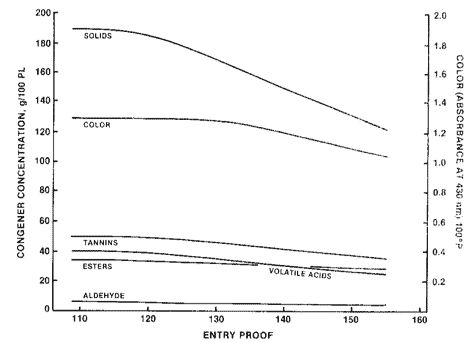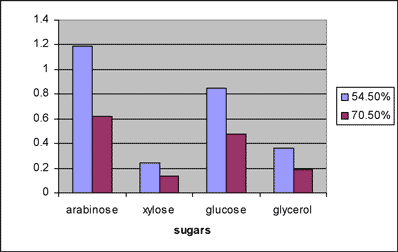

The effect of entry proof (cask filling strength) on whisky maturation
Most of the whisky amateurs know the Customs & Excise regulations regarding the whisky production, which mention that Scotch whisky has to be distilled in Scotland at a strength lower than 94.8% alcohol by volume (abv), matured in oak casks for at least 3 years in Scotland and bottled at a strength of 40% abv or more.
As mentioned in almost any distillery tour or whisky book, the spirit flowing out of the spirit still is reduced to 63.5% abv by adjunction of distilled water, or in a few cases, by source water before cask filling. Many enthusiasts consider this procedure as part of the Scotch whisky Customs & Excise regulations. However, the filling strength of the cask is not regulated and every distillery is free to fill its casks to its desired strength (pending local regulations).
Why 63.5%?
If a whisky will be bottled at market strength, usually between 40 and 46% abv, why would you reduce the spirit before filling the cask and one additional time just before the bottling? Also, cask storing, management and handling are expensive processes. Since every single whisky company is keen on reducing costs why would they dilute the whisky before cask filling and thus increase the number of casks and its associated burden?
When you ask distillery managers or anyone involved in the trade, the most common answers are “I don’t know” or “we always did it this way”.
When reading some whisky books written in the seventies, or before (e.g., Scotch Whisky by D.Daiches or Scotch by Sir R.B. Lockhart), this is not even mentioned. I went through the scientific literature and I found a very interesting article: “Chemical Mechanisms of Whiskey Maturation” published in 1981 (vol. 32, N° 4, p.283-289) in the American Journal of Enology and Viticulture by George H. Reazin, who was working for the famous Seagram company (which at that time owned Chivas and many distilleries, including The Glenlivet). This article covered the chemical mechanisms of whisky maturation, the effect of the casks (refilling and charring effect) as well as the effect of the entry proof on whisky maturation. (Note: The American degree proof is a measure of the alcohol volume. the American proof corresponds to half the abv, e.g., 100 proof = 50% abv. Noteworthy is that the British proof is not the same as the American proof.)
As you can see on the chart below (Figure 1), which is copied from the publication of Reazin, the formation of congeners (the chemical compounds responsible for the flavours of whisky, i.e., volatile acids, tannins) decreases once the filling level reached 120 proof (60% abv). With a filling strength of 63.5%, it is above the optimal strength and some effects on tannins, volatile acids, solids and aldehdydes formation rates should occur. Furthermore, as illustrated on Figure 2, the formation of sugar is strongly affected by the filling strength.
Why does the filling strength have an effect on the maturation?
Whisky is not a highly purified (rectified) alcohol like Vodka or other white spirits. It is produced from barley and distilled between two and three times in copper pot stills with a spirit running out of the spirit still at a strength between ~56 and 72 % abv. Whisky thus contains a huge diversity of chemical compounds (over 400). Maturation occurs in a wooden cask, which has been previously toasted or charred and which previously contained one another alcoholic beverage (wine, Port, Sherry, Rum or other). During the maturation process, the compounds originating from the distillate will react with the compounds present in the wood and chemical reactions will take place. The mechanism of maturation is not completely understood, but the ratio water: ethanol (or water:alcohol) is known to be important for many chemical reaction. In this case, too much alcohol will reduce the hydrolysis ("degradation") rate of sugar from the wood (e.g., xylose) and the production of volatile acids and tannins.

Figure 1: Effect of entry proof (U.S.) on the formation of congeners after 6 years of maturation. Copied from G.H. Reazin, Am. J. Enol Vit, 1981, vol. 32, N° 4, p.283-289.

Figure 2: Effect of the degree proof on sugar formation after 4 years of maturation (blue: entry proof level 54.5% abv and red 70.5%). Based on the data of G.H. Reazin, Am. J. Enol Vit, 1981, vol. 32, N° 4, p.283-289.
So what?
The article of Reazin was limited to the effects of the entry proof during a maturation period of 6 years. At some exceptions, such as the Glen Grant 5YO and Macallan 7YO for Italy, or the very young Ardbeg, single malts are matured for a period of 10 to 16 years. As mentioned, 63.5% seems slightly above the optimal conditions of 60% abv. Since alcohol concentration decreases with time (the "Angel's share"), under normal Scottish climate conditions, the spirit will be in the optimal range within 4-5 years of maturation. I could not find any reference about the filling levels used by the distilleries before the 1980s, but I would not be surprised if this strength of 63.5% was discovered by trial and error prior to Reazin’s work. Reducing the spirit to 60% or less would result in an increase in the amount of sugars and other small carbon derivates (e.g., short chain fatty acids, C3-5) during the maturation but also in a increase of costs, with the risk of a cask dropping to a strength below 40% more rapidly. Not reducing the spirit to 63.5% before cask filling will result in a slower maturation, but also reduced cask management and storage place. During the last years of the Brora distillery, the distillate was filled unreduced in the cask for financial reasons. Brora was closed in 1983 during the whisky depression of the 1980s and Diageo had already too much stocks of whisky, therefore they decided to save money and to use as few casks as possible. The same strategy was also used at, e.g., the Port Ellen distillery. As a result, the quality of the Brora’s whiskies after 20 to 30 years of maturation is quite impressive and the whisky is not woody. The only distillery that is currently filling its casks without reduction is Bruichladdich, since 2001. In “Peat, Smoke, and Spirit” by A. Jefford, Duncan from Bruichladdich told the author “We can’t afford to be storing water (..) and it can end up under strength.”. This does also suit the philosophy of the distillery of “ leaving the product intact”.
Maturation is a long term process, with its known and unknowns and difficult to predict. In conclusion, it seems that filling the cask at 63.5% seems to be the best compromise between the “quality and speed of maturation” and economical considerations (cask storage, handling and management).
Slainthe
Dr. P.Brossard ©July 2006